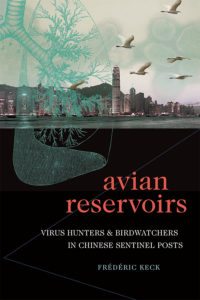Reviewed Book
Avian Reservoirs: Virus Hunters and Birdwatchers in Chinese Sentinel Posts. Frédéric Keck, Durham: Duke University Press, 2020, 245 pp.

In this quirky and unsettlingly timely book (published just as COVID-19 was first emerging), Frédéric Keck explores the tense and complex relations among humans, birds, and microbes that have emerged in three Chinese-speaking territories: Hong Kong, Taiwan, and Singapore. He juxtaposes differing strategies for responding to emerging infectious disease threats (such as prevention vs. preparedness) with differing ways of interacting with biological creatures and their movements (such as sacrificing birds vs. stockpiling viruses) to create a cultural account of the intertwined worlds of virology, birdwatching, and global health. The result is a neo-structuralist narrative of pandemic preparedness that veers wildly from the dusty bookshelves of graduate school seminar staples to the pristine labs of Hong Kong.
Keck couches the uncertainty and anxiety that are inherent to managing outbreaks of emerging infectious diseases in the language of classic French and British social theory. Moving from Spencer to Durkheim to Lévi-Strauss, he links different historical disease outbreaks to different modes of response (prevention, precaution, preparedness), and then argues that these different modes are reflective of the modes of inquiry of different social theorists. The deep dive into 19th- and early 20th-century social theory felt like a strange way to start a book on emerging disease threats, but it sets the tone that Keck seems to want to establish: There is much that is theoretically rich and not at all new about the ways that people manage and react to new infectious disease threats. This book pushes the boundaries of that theoretical richness.
The chapters that follow explore a number of phenomena that may seem disparate but that Keck effectively links together: birdwatching, conservation biology, bird migration patterns, taxidermy, freezing of biological specimens, small-scale animal husbandry, Chinese diaspora politics, and desktop disaster scenario planning. He lingers as long in the weeds of ornithology practices and duck hunting as he does in the halls of scientific power. This approach is most effective when he builds direct bridges between these worlds, as he does, for example, in a long passage about his tutelage at a rural Hong Kong chicken farm that is trying to improve its biosecurity practices.
As interesting as these forays into the mechanics of bird preservation and the storage of bird feces are, the real meat of Keck’s contribution lies in his accounts of the discourses that spring up around an expected apocalyptic event for humans at the hands of birds. Keck contends that pandemic simulations, far from merely preparing for a real event, are a “public health ritual” meant to justify to the public all the work that the scientists are doing. It is all these trappings of preparedness that help people feel justified in their assumptions that if the apocalypse comes, the scientists and the government(s) will know what to do. But Keck reminds us that “nature” is much smarter and wilier than most people give it credit for. As he puts it in the conclusion, “A bird flu pandemic is thus the reversal, as in a mirror, of a bird species extinction: an imaginary revenge of the birds against the way humans treat them” (p. 175). This insight has plenty to teach us about human–environment relations that go much beyond bird flu.
Those looking for pragmatic answers to questions about how our current COVID-19 pandemic crisis happened or what to do about it will not find those answers here. Keck’s project is unapologetically theoretical, and he is far more interested in drawing surprising connections between 21st-century lab science and 20th-century social theory than in making an intervention into global health science or contemporary pandemic politics. For this reason, this book would probably not be an appropriate addition to a global health lecture course or an undergraduate seminar on the anthropology of infectious disease, and public health experts with little experience in anthropology are unlikely to pick it up. With its insistence on applying colonial-era social theory to Chinese chicken farms, Keck’s book also would not be a good candidate for filling out a decolonized curriculum. But for graduate students looking for fresh ways to think with the theory they learn in first-year seminars, and for any other scholar who delights in exploring new ways of imagining human–animal relations, this book is a welcome addition to the anthropology of science, to science studies, and to the history and sociology of infectious disease.
It is an eerie experience to make one’s way through this book during the apotheosis of the very event that Keck’s interlocutors were awaiting. In reading Keck’s account, one becomes acutely aware of the futility of the massive scientific undertaking that he describes. Keck’s work mirrors the work of his interlocutors in being specifically focused on the microbial threat of bird viruses—but COVID-19 does not appear to have originated in birds. He and his interlocutors also were confident that the next catastrophic pandemic would be a type of influenza—but it wasn’t. Finally, perhaps most importantly, all the many scenarios, simulations, and precautions that Keck carefully and almost lovingly describes seemed to do little to accomplish what they were intended to do: Prevent, or at least mitigate, a disastrous viral pandemic. The location of the intensive bird flu-related exercises that Keck describes might perhaps help explain why the three territories he visited—Hong Kong, Taiwan, and Singapore—have done particularly well in their own fights against COVID-19. Yet I couldn’t help thinking that perhaps if the world’s greatest minds had spent less time guessing which bird flu strains might make the jump to humans and more time figuring out how to stockpile ventilators and distribute hand sanitizers, we might not be in quite the situation we are in now. But hindsight is always 20/20.